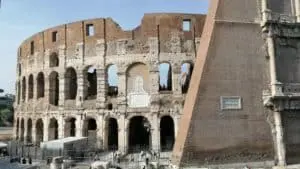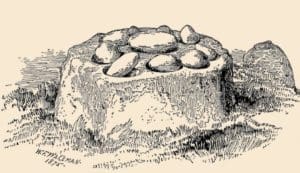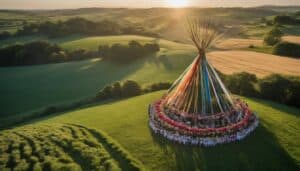The Celtic Culture and Its Global Influence

Updated On: April 22, 2024 by Panseih Gharib
Throughout history, Ireland’s verdant shores have given rise to a rich tapestry of cultural traditions that have swept across the globe. From the haunting melodies of Celtic music to the rhythmic Irish step dancing, elements of Celtic culture have permeated far beyond their origins. With waves of emigration, especially during the 19th and 20th centuries, Irish people spread their customs and traditions worldwide, taking root in the hearts of many diverse populations.
Around the world, celebrations such as St. Patrick’s Day have transcended their Irish origins to become global phenomena, showcasing the enduring allure of Irish traditions. The Gaelic language, although facing challenges, has witnessed a resurgence in interest, symbolising the resilience and pride found in Irish heritage. Despite geographical distances, the essence of Celtic culture continues to thrive internationally, influencing literature and the arts and causing a ripple effect of cultural renaissance in our modern identity.
The Roots of Celtic Culture
As we trace the Celtic culture to its origins, we find a rich tapestry woven from history, tradition, and artistry that remains influential today.
Historical Overview
The Celts were a diverse group of Iron Age tribal societies that flourished across Europe during the Hallstatt and La Tène periods, starting around the 12th century BCE. Originating in central Europe, the culture spread widely and even interacted with the Ancient Greeks, who called them Keltoi, and the Romans, notably under Julius Caesar. This expansion saw the Celts inhabiting areas from Gaul (modern-day France) to Galatia in Asia Minor. In Ireland, the Gaels, a Celtic group, established a lasting presence, marking the country’s culture with their enduring legacies.
Celtic Language and Literature
The Celts spoke various languages and dialects which fall under the Celtic language family, comprising two main branches: Goidelic (or Gaelic) and Brythonic. These languages have survived in several regions, including Ireland, where Irish Gaelic is still spoken. The literary tradition of these languages boasts a vast collection of myths and sagas, which were initially preserved through oral tradition before being transcribed in medieval manuscripts. Celtic literature is celebrated for its intricate tales of heroism, romance, and magic, reflecting the time’s belief systems and societal structures.
Celtic Art and Design
Celtic art is renowned for its elaborate patterns, intricate knots, and symbolism. Hallmarks of Celtic design often feature zoomorphic motifs, complex interlacing, and spirals, indicative of their craftspeople’s skill and aesthetic sensibilities. Notable in metalwork, stone carvings, and illuminated manuscripts, these designs influenced art across regions where the Celts settled or traded. Even today, Celtic art and design hold a significant place in the cultural identity of regions with Celtic roots and are admired for their timeless beauty.
Irish Traditions and Their Evolution
In the tapestry of global culture, Irish traditions have shimmered through the weft and weave of time, adapting and inflecting with each new generation. Today, we celebrate an evolved yet unmistakably Celtic heritage that has moved far beyond the moors and mists of Ireland.
Folklore and Mythology
The chronicles of Irish folklore and mythology have preserved a world where the fantastical and the everyday intertwine. Legends like Cú Chulainn and the Tuatha Dé Danann have survived through oral tradition and found new life in literature and film, reflecting their adaptability to modern mediums. The sagas and myths, once shared by the fireside, are now the fabric of contemporary fantasy genres, demonstrating the Celtic culture’s enduring appeal and the ability of ancient tales to find resonance in present times.
Music and Dance
The heritage of traditional Irish music and step dancing continues to captivate worldwide audiences. Ensembles travelling globally have showcased the intricate melodies of the fiddle and the bodhrán, bringing the communal energy of an Irish céilidh to stages across continents. The spirited jigs and reels have inspired the evolution of step dancing, which has leapt from the rural dance halls to the grand arenas where shows like “Riverdance” have become synonymous with Irish culture’s dynamism.
The Gaelic Language’s Resilience
Before we delve into the specifics, it’s essential to recognise that the Gaelic language, known as Gaeilge in Irish, has weathered extensive social and political changes, maintaining a vital link to Celtic culture identity and Irish literature.
Gaeilge in Ireland
Gaeilge remains a living language in Irish traditions, intertwined with national identity, and consistently celebrated in literary works. The language’s survival is a testament to its significant cultural importance, seeing revival efforts from educational initiatives to government policies. Daily, Gaeilge is nurtured in Gaeltacht regions, where it thrives as a community language, and across the country in schools as a compulsory subject, embodying the resilience of an ancient tongue in the modern world.
Gaeilge Abroad
Gaeilge has planted roots far beyond Ireland’s shores, flourishing within Irish communities around the globe. Emigrants have carried the torch of Gaelic traditions and language, creating pockets of Irish-influenced linguistic landscapes. In these diaspora communities, Gaeilge serves as a means of communication and a proud emblem of Celtic culture, cementing its continued relevance and durability. Literary works and Irish literature abroad often draw upon this rich linguistic heritage, reinforcing the cultural bond among the global Irish community.
Festivals and Celebrations
Irish traditions are richly woven into various global festivals and celebrations, drawing communities together to honour tradition and heritage.
Samhain and Halloween
Samhain, the ancient Celtic festival heralding the end of the harvest season, has deep roots in Irish tradition. It marks the beginning of the “darker half” of the year and is traditionally celebrated from October 31st to November 1st. This festival was the precursor to what we now celebrate as Halloween, an event widely observed across the globe with costumes, trick-or-treating, and an array of spooky-themed activities. It is a prime example of how Irish traditions have radiated beyond its borders, fostering a sense of shared experience within the international community.
Patrick’s Day
St. Patrick’s Day is synonymous with Irish traditions, serving as a beacon of festivity celebrated worldwide on March 17th. Commemorating St. Patrick, one of Ireland’s patron saints, the day galvanises Irish communities and enthusiasts alike to participate in parades, wear green, and enjoy Irish music and dancing. The global reach of this festival is a testament to its ability to unite diverse groups of people under the shared banner of Irish tradition.
Influence of Irish Literature
Irish literature has played a pivotal role in shaping Ireland’s culture and left an indelible mark on the literary world. This section delves into the notable contributions and figures that have championed Irish narratives globally.
Famous Works
Irish literature distinguished itself with several works that have gained international acclaim. James Joyce, a titan of modernist literature, authored Ulysses, a groundbreaking novel that challenged the conventions of narrative structure and prose. Additionally, the storytelling tradition, deeply rooted in Irish culture, has culminated in literature that reflects Ireland’s rich history, mythology, and experience with diaspora.
Other contemporary Literary figures, such as W.B. Yeats and Samuel Beckett, have also contributed to securing Ireland’s reputation as a land of literary giants.
Migration and the Irish Diaspora
We’ve witnessed the significant impact of the Irish diaspora, which has essentially shaped a global network of Irish identity and community.
Historical Migration
Our exploration into the Irish diaspora traces back to the stark adversity our ancestors faced, prompting extensive migration from our homeland. Scores of Irish left during the Great Famine from 1845-51, fundamentally establishing pockets of Irish society within the United Kingdom and across the Atlantic. This departure, born out of necessity, carved out new opportunities in distant lands while preserving our national identity’s essence.
Economic conditions and political turmoil continually influenced migration trends. For instance, in the 1940s, many sought refuge in dire circumstances, perpetuating the spread of our cultural heritage and the formation of new communities. Notable is the influence of Irish migrants in the Balkans, who maintained their cultural identity despite being far from Ireland.
Contemporary Irish Communities
In the present day, the European Union’s framework of free movement has fostered a new wave of Irish migration. It’s not just about seeking prosperity; it’s also about creating and sustaining a sense of community. Globalisation has enabled the Irish to blend into many societies while fostering unmistakably Irish connections.
Contemporary Irish communities are a testament to our adaptability and cultural resonance. These communities actively participate in their local societies yet remain distinctly Irish. Whether through Irish-themed pubs, St. Patrick’s Day celebrations, or Irish cultural festivals, the capacity to unite and kindle the spirit of our homeland illustrates the profound links between migration, diaspora, and enduring Irish identity.
Preservation of Heritage

Recognising the roles played by various cultural entities is crucial to the commitment to honouring and maintaining Irish culture globally. The focus revolves around preserving the vibrancy and legacy of Irish traditions through dedicated organisations and scholarly contributions.
Cultural Societies and Schools
Cultural societies and schools form the backbone of our efforts to sustain the rich tapestry of Irish heritage abroad. These institutions actively promote the celebration of Irish festivals, teaching the Irish language, and practising traditional Celtic art forms. They serve as community hubs where both Irish expatriates and enthusiasts of Irish culture can connect and immerse themselves in cherished traditions.
- Irish Studies: A key academic branch dedicated to spreading knowledge about Ireland’s history and societal impacts.
- Celtic Art Classes: These courses ensure the transmission of unique Irish artistic skills to newer generations.
Museum and Academic Contributions
Museums and academic institutions globally contribute significantly to the preservation and exhibition of Irish artefacts, providing insights into the ancient roots of Celtic society. Archaeologists have been instrumental in uncovering artefacts that trace back to the Celts, allowing us a tangible link to the past.
- Archaeological Exhibits: Display artefacts and explain their relevance to understanding Irish heritage.
- Scholarly Research: Papers and studies published on topics ranging from ancient Irish archaeology to contemporary cultural practices.
Through these concerted efforts encapsulated in societies, schools, museums, and academia, we ensure that the legacy of Irish culture remains vibrant and accessible for generations to come.
Interactions with Other Cultures
As we trace the footprints of Celtic culture across the globe, we observe a rich tapestry of interactions where trade and artistic exchange foster a melding of traditions and the spread of Celtic influences far beyond its European origins.
Trade and Artistic Exchange
Through trade, Europe’s Celtic nations like Scotland and Ireland historically exchanged goods and artistic designs with neighbouring regions. The iconic knotwork and intricate spirals often found in metalwork and stone carvings are a testament to this cultural interplay. For instance, with its ornate illustrations, the Book of Kells is renowned worldwide and reflects a fusion of Celtic and Christian influences. Moreover, our trade with regions such as Central and Western Europe and Brittany has introduced Celtic designs, often adopted and adapted, showcasing the fluid nature of artistic exchange.
Celtic Influence Beyond Europe
Celtic customs, music, and festivals have found a home in far-flung places, capturing hearts well outside the traditional Celtic heartlands. For example, St. Patrick’s Day festivities turn cities around the world green, echoing Ireland’s cultural pride globally. The sounds of Celtic music also inspire contemporary genres, and it’s not uncommon to hear the lilting melodies of a Celtic fiddle within modern soundtracks. Brittany, of particular note, maintains strong Celtic connections through its music and language, which are rooted deeply in Celtic tradition and demonstrate the enduring nature of Celtic influence.
Modern Identity and Cultural Renaissance

The re-shaping of Irish identity and the cultural renaissance of Ireland are intricately linked to the economic boom and renewed interest in Celtic traditions. This transformation has seen a dynamic interplay between modern societal changes and a revival of cultural heritage, impacting how Irishness is perceived and expressed globally.
Celtic Tiger Era
From the mid-1990s until the late 2000s, the Celtic Tiger period marked extraordinary economic growth in Ireland. This era forged a new identity as Ireland transitioned from a largely agrarian society to a tech-driven economy. The affluence of this time enabled a resurgence in the appreciation of Irish culture at both national and global levels. Notably, the Celtic Tiger allowed Ireland to broadcast its rich cultural legacy to a broader audience, altering the perception of Irishness worldwide.
Revival of Traditions
The economic prosperity of the Celtic Tiger years also sparked a renewal of interest in Ireland’s cultural roots, leading to a revival of traditions. Irish music, dance, and language saw a resurgence within the country and amongst the Irish diaspora. This renewal has bolstered a sense of national pride and firmly established Celtic culture as a significant part of the global cultural fabric. The international celebration of St. Patrick’s Day and the worldwide popularity of Irish pubs are testaments to these traditions’ enduring appeal and legacy.
Our modern society continues to intertwine these revived traditions with contemporary expressions of Irishness, shaping a global cultural identity that honours its past while continuously evolving.
Challenges and Prospects for the Future
In addressing the future of Irish and Celtic culture abroad, we recognise the challenges and prospects inherent in its dissemination. One of the primary challenges lies in preserving the Irish language, which is integral to the culture’s unique identity. With English being widespread, encouraging the younger generation to maintain fluency in Irish remains a crucial endeavour.
Preservation Efforts
- Teach Irish in schools and communities abroad
- Support Irish language media
Amidst growing modernisation, traditional customs may lose prominence; therefore, sustaining these practices within the global Irish community is paramount. This includes promoting traditional Irish music, dance, and festivities, particularly in areas where the Irish diaspora has a strong presence.
Community Engagement
- Organise cultural festivals and events
- Fund programmes for traditional arts
Another focal point is Irish society’s role and ability to adapt while keeping the essence of its heritage alive. Cities like Dublin, embodying a rich Celtic past, can act as cultural ambassadors, fostering a network through which Irish customs can flourish internationally.
Global Collaboration
- Create initiatives with global Irish societies
- Establish ties with cultural organisations worldwide
Given these challenges, the prospects are nevertheless promising. We are witnessing a conscious effort to revitalise Celtic culture through various platforms, like Connolly Cove, which has become an advocate for Irish heritage globally. As societies evolve, there will always be room for the Celtic spirit if nurtured with due thought and respect for its roots.
Educational Development
- Encourage academic studies in Celtic history and society
- Support scholarships for international students in Irish studies
Our vision for the future balances innovation and tradition dynamically, ensuring that Irish culture endures and adapts creatively to the global community.
Conclusion
In every corner of the world, from the United States to Australia, the historical and ongoing journey of the Irish people continues to signify the nation’s indomitable spirit and cultural richness well beyond the geographical confines of Ireland.






